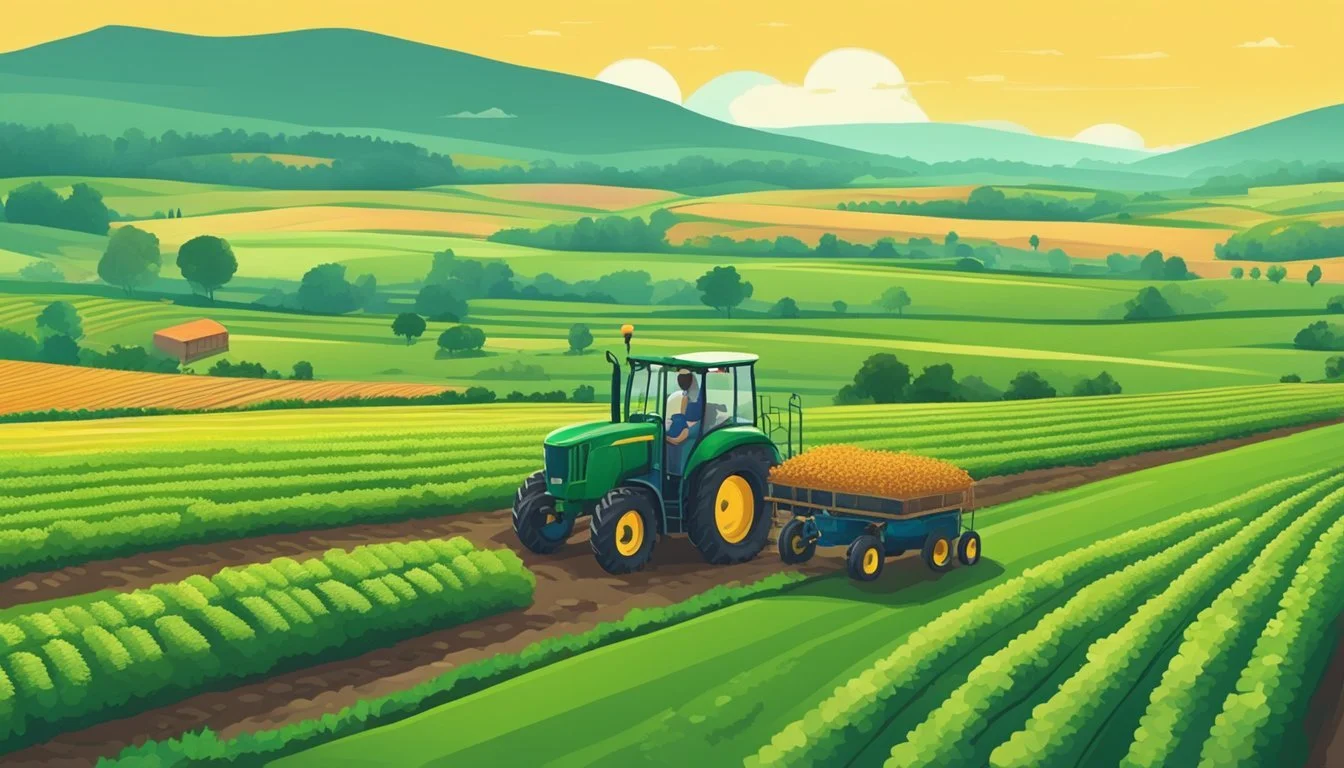Right to Farm Law in California
Navigating Agricultural Protections & Conflicts
The Right to Farm Law in California serves as a shield for agricultural operations, affirming the right to continue long-standing agricultural practices despite the encroachment of urban development. As urban growth reaches into rural areas, instances of conflict between new residents and existing farming operations become more frequent. The law is designed to protect farmers from nuisance lawsuits, which may be brought by newcomers who are unaccustomed to the realities of agricultural life, including noise, odors, and the visual impact of farming.
This statute, codified under California Civil Code 3482.5, specifies that agricultural activity, as long as it is conducted in a manner consistent with proper and accepted customs and standards, shall not be deemed a nuisance. The law thus establishes a legal framework that favors ongoing agricultural practices, preventing new residents in a rural area from successfully filing a nuisance suit against existing farming operations simply due to a change in the neighborhood landscape.
Despite this statewide statute, local governments in California have the authority to strengthen the protections offered under the Right to Farm Act through county-level ordinances. These local enhancements to the law often provide additional layers of security for farmers, reinforcing the state's commitment to its agricultural heritage and ensuring that farming remains viable in the face of California's dynamic growth and development patterns.
Historical Context of Right to Farm
The California Right to Farm laws were instituted primarily to protect agricultural operations from nuisance lawsuits as urban growth increasingly encroached upon farming areas.
Evolution of Farming and Law
The transformation of California's landscape to accommodate urban growth has frequently resulted in conflicts between agricultural and residential land uses. As urban development advanced into traditional farmlands, the need to safeguard the agricultural community became evident. The notion of "Right to Farm" laws emerged as a critical legal mechanism to address the inherent tensions between newly-arrived residents in former rural spaces and the long-established farming activities.
Critical Legislation Milestones
1981 Enactment
The pivotal statute in the state's history of agricultural protection is the California Civil Code Section 3482.5. Enacted in 1981, this law was a legislative response to the increasing disputes arising from the proximity of residential areas to farm operations.Scope and Impact
The law clarified that an agricultural operation is not deemed a nuisance, traditionally defined as an act that disrupts the enjoyment of one's property, if the condition or practice has been in operation for more than three years, is lawful, and was not considered a nuisance when it began.Statutory Reinforcement
California’s Right to Farm Act superseded local regulations but was strengthened by county-level ordinances. These local ordinances enhanced the protections provided by the state, delineating clearer lines of defense for ongoing farming operations against the potential for nuisance claims.
Residents moving into the rural areas have had to recognize that pre-existing agricultural activities are legally protected, significantly reducing the viability of lawsuits based on the disturbance by normal farming activities. Conversely, agricultural operations are encouraged to persist, contributing to the prevention of farmland loss to urban development.
Purpose and Core Principles
The Right to Farm Law in California serves to shield customary agricultural practices from being deemed a nuisance, thereby safeguarding the livelihood of farmers and the agricultural industry as a whole.
Protection of Farming Practices
Right-to-farm laws are designed to protect the ability of farmers to conduct their agricultural activities without the threat of nuisance claims. California's legislation specifically ensures the security of a wide range of agricultural practices, including:
Cultivation and tillage of the soil
Dairy operations
Production of agricultural commodities such as timber, viticulture (grape-growing), apiculture (beekeeping), horticulture, livestock, fur-bearing animals, fish, and poultry.
These practices are protected when conducted in a manner that conforms with proper and accepted customs and standards established by similar agricultural operations in the same locality.
Minimization of Nuisance Lawsuits
The intent behind these laws is to minimize nuisance lawsuits against farming operations. They establish that if a farming operation, facility, or its appurtenances, which includes all accessory structures and processes necessary for the farm's operation, is conducted in a commercially viable manner consistent with proper and accepted customs, it cannot be deemed a private or public nuisance. This legal framework is significant because it:
Prevents the disturbance of agricultural activities by the complaints of newcomers to a locality who may not understand the realities of living near a farming operation.
Affirms the value of agriculture by prioritizing standard farming operations over competing land uses in the same area.
By enshrining these protections into law, California recognizes the importance of farming to the state's economy and cultural heritage, and aims to prevent legal challenges that could hinder agricultural productivity.
Key Provisions and Legal Language
In the context of agricultural operations, the Key Provisions and Legal Language of California's Right-to-Farm Act establish a framework that aims to shield customary farming practices from nuisance lawsuits, provided these practices are conducted properly and without negligence.
Scope of the Right-to-Farm Act
The Right-to-Farm Act in California, codified in California Civil Code § 3482.5, is designed to protect agricultural activities from being considered a nuisance. This statutory scheme is particularly important in mitigating nuisance suits that could arise from the operational norms of agriculture. It should be noted, however, that there are exceptions; for instance, the protection does not extend to practices that obstruct the use of public resources or thoroughfares.
Definitions and Terms
Key terms within the Right-to-Farm Act are defined to clarify the scope of protections. Agricultural activity, as per the statutory language, includes all necessary conditions and operations for the production of crops and livestock. This broadly encompasses cultivation, growing, and harvesting of any agricultural or horticultural commodities. The Act specifies that when an agricultural operation has been established prior to surrounding nonagricultural activities, it will generally not be deemed a nuisance barring circumstances where it was not operated in a reasonable and lawful manner.
Relevant research publications and commentary from the National Agricultural Law Center may contribute to the interpretation and implications of the Act's language in legal scenarios, although specific applications often depend on case-by-case judicial assessments.
Implementation and Enforcement
In California, the Right to Farm Law is applied and supervised at both the state and local levels. This legal framework serves to protect agricultural activities considered acceptable practices from nuisance lawsuits.
Role of Local Authorities
Local governments are vital for the implementation of Right to Farm laws. They enact ordinances that align with state-level statutes to support local agricultural conditions. These ordinances serve to inform qualifying farmers and ranchers of their rights and responsibilities under the law. Ranchers and farmers within the jurisdiction benefit from these regulations as they provide the groundwork for deemed acceptable farming practices, potentially including timelines and specific guidelines for agricultural operations.
Legal Recourse and Defense
Right to Farm laws offer farmers a defense against civil actions claiming nuisance. In the event of a legal dispute, farmers and ranchers may reference Right to Farm ordinances to assert that their practices are protected. When government agencies become involved due to reported nuisances, they must consider these statutes when determining the legitimacy of any claims. It’s important that farmers adhere to accepted farming practices to qualify for this defense, as deviations may result in the loss of protection under the law.
Impact and Challenges
The Right to Farm Law in California represents an intricate balance between preserving agricultural activities and managing the encroachment of urban development. This law has been critical in protecting farming operations from nuisance actions that may arise from such encroachment. However, it faces numerous challenges in effectively safeguarding these interests while addressing environmental concerns.
Agricultural vs. Urban Interests
A fundamental tension exists between agricultural and urban interests in California. On one hand, farming operations are necessary for food production and economic health; on the other, urban growth demands land and can lead to conflicts. The Right to Farm Law's impact is evident in how it limits nuisance actions against farmers, which could arise due to odors, noise, or other inconveniences typical of farming. However, challenges surface in zones where residential development nears agricultural land, prompting disputes that test the strength and applicability of the law.
Zoning: Efforts to clearly define agricultural zones and implement stringent measures to protect these from urban sprawl are crucial.
Mitigating Nuisance: The law works to preclude complaints against normal farm practices, but as urban areas expand, the number of conflicts tends to increase.
Environmental Considerations
While the Right to Farm Law protects farming practices, it also faces challenges related to environmental sustainability. Practices within livestock management and other areas of agribusiness come under scrutiny due to environmental impacts such as water usage and waste management. Striking a balance between operational protections and environmental stewardship remains a key issue.
Environmental Impact of Livestock: Livestock are essential to many farms, but they can produce significant odors and waste, leading to potential environmental health concerns.
Sustainable Farming Practices: Encouraging sustainable practices is crucial as farming operations adapt to better suit environmental needs, which may include more stringent regulations and industry-led initiatives.
Urban Growth: Smart planning is necessary to accommodate growth without compromising agricultural land, which often requires collaboration between local governments, developers, and the farming community.
Comparative Analysis with Other States
This section provides a focused comparison of California's Right to Farm (RTF) law with RTF laws in various other states, highlighting legislative differences and how court interpretations have shaped the application of these laws.
Legislative Variations
California's RTF law, codified in California Civil Code § 3482.5, grants farmers immunity from nuisance suits provided they comply with properly conducted agricultural operations. It was established in 1981 to protect agricultural activities deemed not a nuisance at the time the operation began. In contrast, other states such as Iowa and Indiana have their own versions, which may differ in the scope and the level of protection afforded.
For instance, Arkansas—according to the National Agricultural Law Center—offers RTF protections through Ark. Code Ann. § 2-4-107, where agricultural operations are protected from nuisance lawsuits after a period of one year. Colorado, on the other hand, emphasizes a minimum period before a farming operation is protected, requiring that an agricultural operation be in place for at least one year before it gains nuisance lawsuit protection, similar to Arkansas.
States like Florida and Georgia have also implemented RTF laws, such as Fla. Stat. § 823.14 in Florida and Ga. Code Ann. § 41-1-7 in Georgia, which protect farms from nuisance suits under specific conditions, which vary slightly from those set forth in California. Maine, with 14 M.R.S § 1601, establishes that farming operations cannot be considered a nuisance unless they are negligent or improperly conducted. This slight nuance in language can influence how broadly the law is applied.
Court Interpretations
Court interpretations have been instrumental in defining the reach and limitations of RTF laws. In California, courts have examined the parameters of CC § 3482.5, balancing the interests between agriculture and complaining neighbors. For example, case law has clarified that established agricultural practices protected under the act cannot suddenly be deemed a nuisance due to changing nearby land uses.
In states like Kansas, Illinois, and Indiana, their respective RTF laws have also been the subject of judicial scrutiny. Courts analyze specific statutory language and the intent of the legislature when applying the law to disputes. In Illinois, according to case law, courts have recognized that not all types of farm operations may be protected under the state's RTF provisions.
When courts in different states interpret RTF statutes, the outcomes can inform the broader understanding and implementation of these laws across the nation. These interpretations are paramount in setting precedents that determine the balance between agricultural interests and the rights of other landowners.
The Future of Right to Farm in California
Looking ahead, California's Right to Farm (RTF) laws may face shifts due to changing agricultural trends and potential legislative updates, both crucial for stakeholders including farmers, landowners, and prospective plaintiffs.
Projected Trends in Agriculture
Agricultural practices in California are likely to evolve, driven by technology, sustainability efforts, and market demands. Farmers may adopt more advanced and resource-efficient farming methods to remain competitive and sustainable. While agricultural land use has seen a reduction, there is an ongoing push for preserving farmland and supporting farm longevity, which may lead landowners to adapt in various ways to maintain Right to Farm protections.
Integration of Technology: Precision agriculture and sustainable practices become standard.
Land Use Pressures: The balance between urban expansion and farmland preservation intensifies.
Legal Amendments and Proposals
Legislative adjustments to California's RTF laws are anticipated as agricultural challenges and community interactions evolve. Proposals may aim to better clarify the immunities provided to agricultural activity and provide additional protections or regulations. Legislative updates might address:
Disclosure Requirements:
Current requirements could be reformed to be more stringent, affecting landowner obligations.
Implications for plaintiffs in potential nuisance lawsuits might shift as a result.
Zoning and Regulations:
Updates might include clearer zoning guidelines to reconcile agricultural operations with non-farming land uses.
Potential introduction of buffer zones or other spatial regulations to mitigate conflicts.
As these trends and legal parameters evolve, so will the dynamics between agriculture and overarching societal needs in California.
Resources and Further Reading
In this section, readers interested in the intricacies of the Right to Farm Law in California can access a curated list of academic, legal, and communal resources. These materials are designed for researchers, policy analysts, and anyone looking to deepen their understanding of rural property rights, and they are regularly updated to reflect the latest developments in the field.
Academic and Legal Resources
Legislation Texts: For the primary source of the law, California's Civil Code Section 3482.5, also known as the California Right to Farm Act, is a critical legal document.
Scholarly Articles: JSTOR and other academic databases offer peer-reviewed articles that provide comprehensive rural studies research and in-depth analysis of the Right to Farm law's impact.
Charts and Reports: State departments and university-led research projects often publish up-to-date charts and reports showcasing trends and statistics on farm preservation and property rights.
Community and Advocacy Groups
One Rural: As an organization focused on rural advocacy, One Rural provides insights and summaries detailing how California's Right to Farm law affects local farming communities.
Farmland Information Center (FIC): It is an excellent source for policy updates and assessments on county right-to-farm ordinances in California that reflect the community's perspective.









